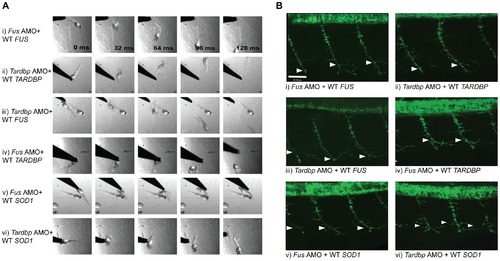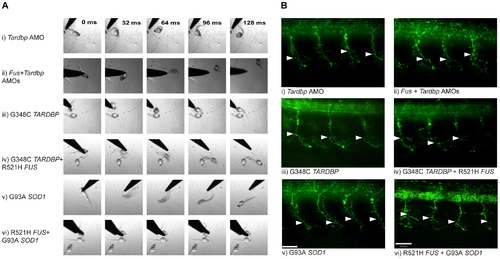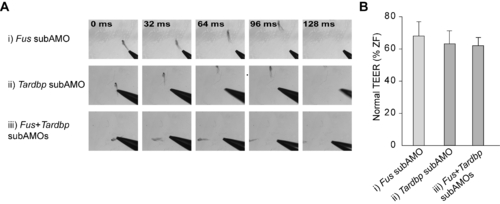- Title
-
FUS and TARDBP but Not SOD1 Interact in Genetic Models of Amyotrophic Lateral Sclerosis
- Authors
- Kabashi, E., Bercier, V., Lissouba, A., Liao, M., Brustein, E., Rouleau, G.A, and Drapeau, P.
- Source
- Full text @ PLoS Genet.
|
Fus mRNA expression in early development of zebrafish and Fus levels are reduced upon KD with a specific AMO. A) In situ hybridization with antisense (upper panels) and sense (lower panel) oligo probes specific to Fus mRNA revealed a predominant expression in the CNS, in particular in the hindbrain, spinal cord, as well as intersomitic segments as shown in B) in 24 hpf zebrafish embryos. C) Western blot analysis of zebrafish embryos injected with an AMO that specifically binds and inhibits Fus mRNA translation, showing reduced levels of Fus expression as compared to non-injected zebrafish embryos and zebrafish embryos injected with an AMO, where 5 nucleotides are mismatched (mismatch). D) WT human FUS mRNA or one of three ALS-related FUS mutations, each tagged with myc, were overexpressed in zebrafish and larval extracts were collected. Immunoblotting with myc antibody reveals similar expression in all these extracts. EXPRESSION / LABELING:
|
|
ALS-related FUS mutations cause a motor phenotype through both gain and loss of function. A) KD of Fus (i) causes a major deficit in the TEER, which can be rescued by WT FUS mRNA (ii). A similar motor phenotype is also observed upon overexpression of mutant R521H FUS mRNA (iv), but not WT FUS mRNA alone (iii). B) Immunocytochemical analysis of axonal projections from spinal cord motor neurons revealed a marked reduction of primary axonal length (arrowheads represent the unbranched axonal length; UAL) upon KD of zebrafish Fus, which could be rescued by co-expression of WT FUS mRNA (ii). A similar axonal phenotype is also observed upon overexpression of mutant FUS mRNA (iv), but not present in zebrafish expressing WT FUS mRNA (iii) alone. C) Both the percentage of fish with normal TEER (upward bars, averages of % of normal zebrafish (ZF) embryos ± standard errors of mean, SEM) and the length of primary motor axons (downward bars, averages of UAL in µm ± SEM) were unaffected or significantly reduced (* for p<0.05 from WT FUS mRNA injections; ** for p<0.05 from WT FUS mRNA injections and Fus AMO; all values given in Table 1) when compared to fish injected with Fus AMO alone (i), Fus AMO and WT FUS (ii), Fus AMO and R521H FUS (iii), Fus AMO and R521C FUS (iv) and Fus AMO and S57Δ FUS (v), or with R521H FUS (vi), R521C FUS (vii), S57Δ FUS (viii) or with WT FUS mRNA alone (ix). Arrowheads represent length to the first axonal branching (UAL). Scale bar: 40 μm. EXPRESSION / LABELING:
PHENOTYPE:
|
|
FUS rescues the motor phenotype induced by Tardbp KD, but not vice-versa. A) Motor phenotype was assessed both by time frames obtained from video recordings of the TEER as well as B) immunohistochemical labeling of the axonal projections to determine UAL in motor neurons. The analysis shows that both expression of WT TARDBP and WT FUS can rescue the motor phenotype caused by KD of Tardbp (i) and Fus (ii) respectively. Furthermore, WT FUS is able to rescue the motor phenotype induced by KD of Tardbp (iii), but WT TARDBP does not rescue the motor phenotype caused by KD of Fus (iv). Similarly, WT SOD1 is unable to rescue Fus (v) and Tardbp (vi) KD phenotypes. Arrowheads represent length to the first axonal branching (UAL). Scale bar: 40 μm. |
|
Mutant SOD1 exacerbates the motor phenotype caused by mutant FUS and mutant TARDBP. A) Motor phenotype was assessed both by time frames obtained from video recordings of the TEER as well as B) immunohistochemical labeling of the axonal projections to determine UAL in motor neurons. The analysis demonstrates that knock-down of both Tardbp and Fus (ii) does not lead to an exacerbated phenotype when compared to phenotypes generated by KD of Tardbp (i) or Fus by AMOs. Similarly, overexpression of both mutant R521H FUS and G348C TARDBP (iv) does not aggravate the phenotype observed by overexpression of mutant TARDBP (iii) or mutant FUS (Figure 2A, 2Biv). However, co-expression of mutant SOD1 and mutant FUS did exacerbate the motor phenotype caused by mutant SOD1 alone (v). Arrowheads represent length to the first axonal branching (UAL). Scale bar: 40 μm. EXPRESSION / LABELING:
PHENOTYPE:
|
|
FUS mutations are unable to rescue the phenotype induced by KD of Fus. A) and B) Motor phenotype was assessed both by time frames obtained from video recordings of the TEER as well as immunohistochemical labeling of the axonal projections of motor neurons to determine the UAL. The analysis demonstrates that two ALS-related mutations, R521C (i) and S57Δ (ii), unlike the R521H mutation, do not induce a significant motor phenotype when compared to WT FUS mRNA expression. Whereas R521C (iii) is unable to rescue the motor phenotype induced by KD of Fus, WT (Figure 2) and the S57Δ mutation are able to rescue the motor phenotype caused by Fus KD in zebrafish embryos. All quantifications of the motor phenotype are given in Figure 2 and Table 1. Scale bar: 40 μm. |
|
TAF15, a FUS homologue is unable to rescue the TEER induced by KD of Tardbp. A) Representative videos showing the TEER when TAF15 mRNA was overexpressed (i), upon Tardbp KD (ii), and co-injection of the Tardbp AMO and TAF15 mRNA. B) Overexpression of TAF15 mRNA was unable to rescue the TEER induced by Tardbp KD. |
|
KD of both Tardbp and Fus in zebrafish does not induce an exacerbated motor phenotype. A) Representative videos showing the TEER of zebrafish larvae when subdoses of Fus AMO (i), Tardbp AMO (ii) and co-injection of both these AMOs (iii). B) An exacerbated TEER phenotype was not observed upon co-injection of both these AMOs. |

Unillustrated author statements PHENOTYPE:
|







